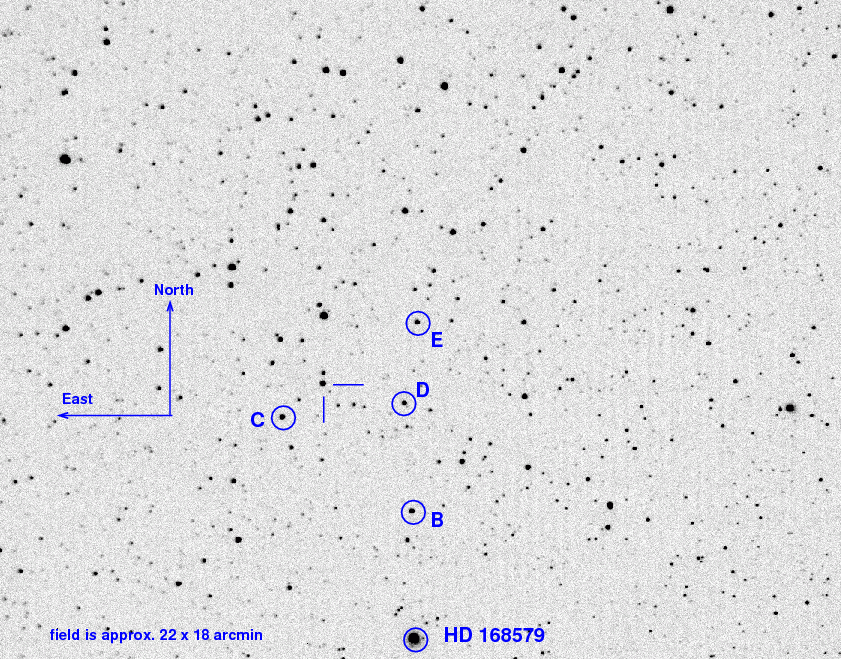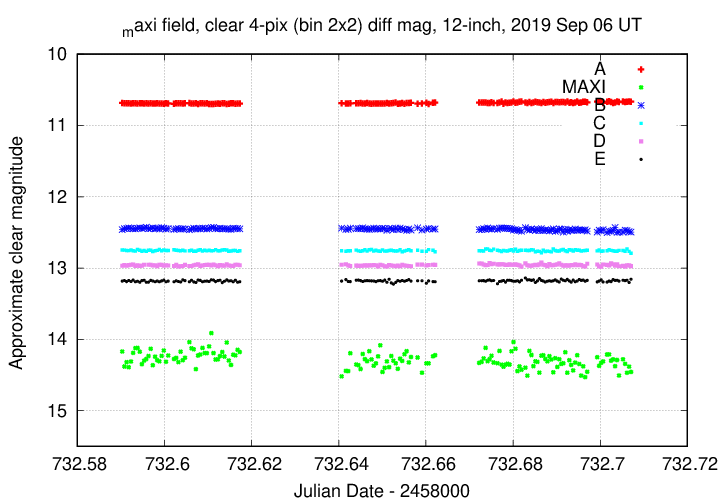
On the night of Sep 05/06, 2019, through dark skies, Dennis Houlihan and I acquired a set of observations of the likely black-hole system MAXIJ1820+070, (also known as ASASSN-18ey ).
Software problems interrupted our measurements twice. Rats. These observations were made at high airmass, up to X = 2.6, as the object is setting earlier and earlier.
This optical and X-ray and radio transient is likely a black hole accreting material at a higher-than-usual rate. It has been the subject of many observers over the past few months -- see the trail of telegrams that include
The main setup was:
Notes from the night:
Be careful not to start two MaximDL processes when setting up all the software at the start of the night.
The object is located at
RA = 18:20:21.9 Dec = +07:11:07.3
A chart of the field is shown below. The size of the chart is about 22 by 18 arcminutes.
I've marked the location of several comparison stars, which also appear in light curves below. Stars C, D, and E are mentioned by the Tomoe Gozen team in ATel 11426, but all three are rather red, with (B-V) ranging from 1.14 to 1.37. Star B is one of the bluest nearby bright stars, with (B-V) = 0.52.
star UCAC4 B V ---------------------------------------------------- B 486-079513 12.975 12.454 C 486-079608 13.968 12.830 D 486-079523 14.637 13.272 E 487-077858 14.637 13.272 ----------------------------------------------------
I ran the camera at -20 C. Nothing out of the ordinary.

The sky value shows that the sky was clear and dark. Note gaps due to computer problems.

Here's a record of the telescope's drift. Note the jumps due to telescope motion; the big one occurred when I re-acquired the field after cycling power to the telescope. Also, I had to stop using the autoguider around 12:05 AM when MaximDL crashed.

The number of objects detected. It drops at the end of the run due to extinction at higher airmass.

I used an aperture with radius 4.0 pixels tonight.

I discarded images which had obvious trailed stellar images, and also images which were outliers in the "image adjustment" plot. (discarded a total of 17 of the 180 raw images).

Using aperture photometry with a radius of 4 pixels (binned 2x2, each pixel is 1.34 arcsec, so a radius of 5.4 arcsec), I measured the instrumental magnitudes of a number of reference stars and the target. Following the procedures outlined by Kent Honeycutt's article on inhomogeneous ensemble photometry, I used all stars available in each image to define a reference frame, and measured each star against this frame.
Sigma-vs-mag plots show that the floor was about 0.010 mag overall. The larger-than-normal value is largely due to the high airmass and differential extinction, I think. MAXI is the outlier at ensemble mag of about 3.6.

Here are light curves of the variable and the field stars.

I used the UCAC value for the V-band magnitude of star "B" = UCAC4 486-079513 to shift the ensemble magnitudes to the standard V-band scale.
Here's a closeup on the variable.

You can download my measurements below. A copy of the header of the file is shown to explain the format.
# Measurements of MAXIJ1820+070 made at RIT Obs, UT 2019 Sep 6, # in fair conditions, # by Dennis Houlihan and Michael Richmond, # using Meade 12-inch LX200 and ATIK 11000. # Exposures 30 seconds long, clear filter. # Tabulated times are midexposure (FITS header time - half exposure length) # and accurate only to +/- 1 second (??). # 'mag' is a differential magnitude based on ensemble photometry # using a circular aperture of radius 4 pix = 5.3 arcseconds. # which has been shifted so UCAC4 486-079513 has mag=12.454 # which is its V-band magnitude according to UCAC4. # # UT_day JD HJD mag uncert Sep06.09028 2458732.59028 2458732.59223 14.170 0.022 Sep06.09079 2458732.59079 2458732.59274 14.380 0.026 Sep06.09128 2458732.59128 2458732.59323 14.320 0.025
Last modified 9/06/2019 by MWR.